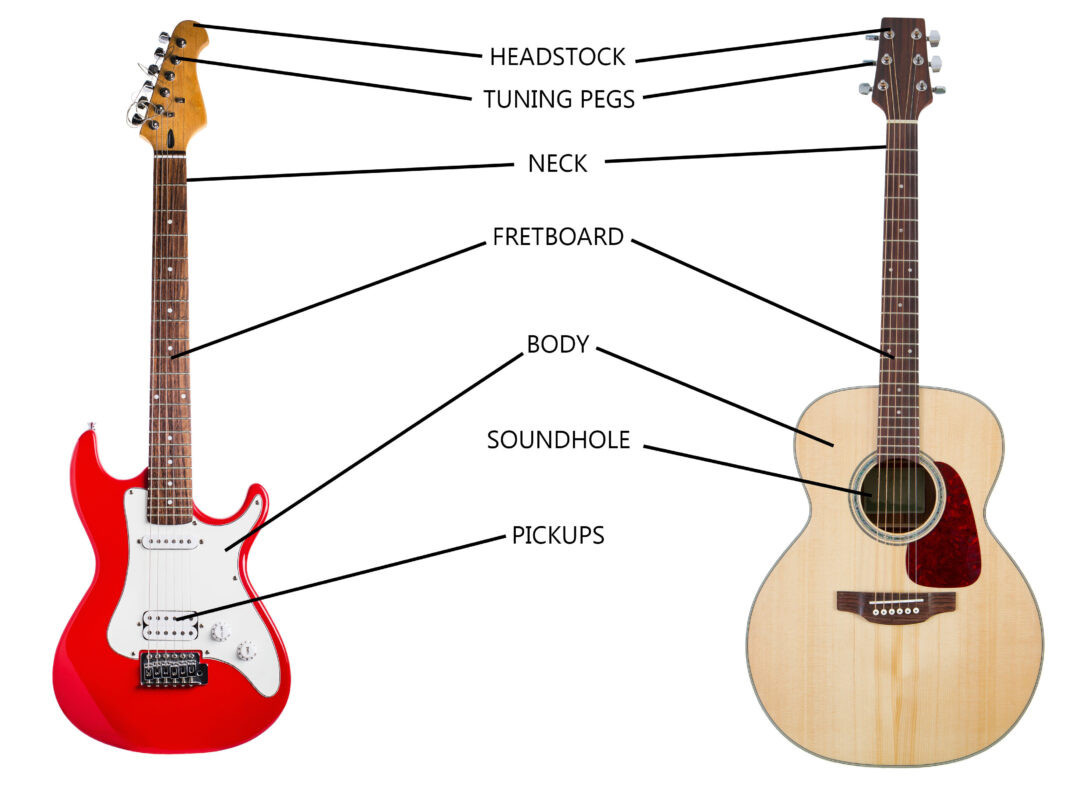The guitar, a beloved instrument across genres and generations, captivates with its melodic versatility. To truly connect with this instrument, understanding its construction is as crucial as learning chords and scales. Delving into the Anatomy Of A Guitar unveils the ingenious design that allows it to produce music and deepens a player’s appreciation for their instrument.
Exploring the Guitar’s Core Components
 Anatomy of an Acoustic Guitar: A detailed illustration showcasing the labeled parts including the headstock, neck, fretboard, body, tuning pegs, and soundhole.
Anatomy of an Acoustic Guitar: A detailed illustration showcasing the labeled parts including the headstock, neck, fretboard, body, tuning pegs, and soundhole.
The Headstock: The Tuning Center
Positioned at the very top of the guitar neck, the headstock is fundamental to string tension and tuning stability. This section houses the tuning pegs, mechanisms critical for adjusting string pitch. When your guitar sounds out of tune, the headstock is where you’ll make adjustments to restore the correct pitch. Headstock designs vary across guitar brands and styles, often serving as a canvas for the manufacturer’s logo.
The Neck: The Bridge to Notes
The neck is the long, wooden piece that connects the headstock to the guitar body. Its dimensions—length, width, and profile—are vital to playing comfort. The neck’s most prominent feature is the fretboard, the surface where players press strings to create different notes. A thorough understanding of the neck’s structure is key to a comfortable and efficient playing experience.
Tuning Pegs: Precision Tuning Mechanisms
Also known as machine heads or tuners, tuning pegs are located on the headstock and are essential for fine-tuning each guitar string. These mechanisms allow for minute adjustments in string tension. By rotating the pegs, you can precisely raise or lower the pitch of each string until the guitar is perfectly in tune. Accurate tuning via the tuning pegs is fundamental to producing harmonious and precise musical sounds.
The Fretboard: Mapping Musical Notes
The fretboard, or fingerboard, is the flat piece of wood affixed to the guitar neck’s face. It’s segmented by metal frets, which are precisely placed to define musical intervals. Pressing a string down behind a fret shortens its vibrating length, thus producing a specific pitch. Inlays, often dots or decorative shapes, are typically embedded at frets 3, 5, 7, 9, and 12 to help players navigate the fretboard visually. The fretboard is the map upon which guitarists create melodies and chords across a broad range of notes.
The Body: The Resonating Chamber
The guitar body is the large part of the instrument that amplifies the sound of the vibrating strings. Guitar bodies come in diverse shapes—like dreadnought, concert, and various electric guitar body styles—each influencing the guitar’s sonic character. Construction materials and body shape significantly impact the guitar’s tone, resonance, and projection.
The Soundhole: Projecting Acoustic Tone
Acoustic guitars feature a soundhole, typically a circular opening in the body. This hole allows the sound produced within the body to escape and project outwards, enhancing the guitar’s volume and tonal richness. The soundhole’s size and location are crucial factors in shaping an acoustic guitar’s unique sound.
Pickups: Capturing String Vibrations Electrically
Electric guitars differ significantly from acoustic guitars by utilizing pickups instead of a soundhole for sound projection. Pickups are electromagnetic transducers positioned beneath the strings. They convert the mechanical vibrations of the guitar strings into electrical signals. These signals are then routed to an amplifier, which dramatically increases the volume. The type, number, and placement of pickups are major determinants of an electric guitar’s tonal range and versatility, contributing to the vast sonic landscapes achievable with electric guitars.
Gaining familiarity with each guitar part is essential for every musician, from beginner to expert. Understanding guitar anatomy empowers players to make informed decisions when choosing instruments, modifying setups, and refining playing technique. Whether you’re just starting your musical journey or seeking to deepen your guitar expertise, further exploration into guitar craftsmanship and playing techniques will enhance your musical path. For in-depth knowledge and skills, resources like Guitar Craft Academy offer expert guidance in guitar construction and musicianship, nurturing a lifelong appreciation for the instrument and music creation.

